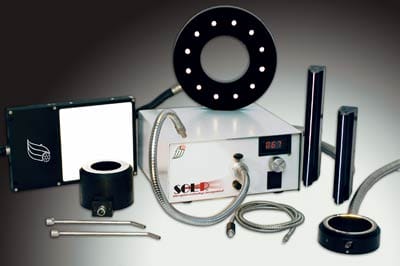
Even in the early days of machine vision, when no one understood the importance of lighting, fiber optic lighting was only considered as a last resort, mostly due to cost. Over time, the industry began to understand the value of fiber optic lighting technology; it has a great ability to shape the illumination for a specific purpose.
Fast forward to 2018, and you’ll find the basic premise of fiber optic lighting still being used, the traditional fiber forming shapes of spot, line and ring lighting, but configured using LED chips, which have continuously shrunk in size and increased in output power. Today’s vision applications can still be served by fiber, and can still compete with LED lighting for several reasons.
1. Fiber optic lighting shapes live forever.
LED configurations have long lives, but if one or two discrete LEDs fail in the lighting component, output uniformity is no longer optimal. You don’t repair these items, you replace them. For fiber, the performance is eternal (or as long as an LED light source can last, and as respectfully as the component is handled, after all, most designs are still made with glass fiber).
2. Fiber optic lighting is insensitive to heat, and can be used to block infrared.
Everyone knows LEDs are heat sensitive. Their life and output both detrimentally affected by heat. Fiber performance is mostly unaffected by heat, and can operate in environments well above the LED limit. Additionally, fiber will not melt or cook biologic samples, but the thermal output of an LED configuration could be troublesome for samples.
3. Fiber optic lighting does not produce sparks and cannot short out.
Some markets/applications require lighting in explosive or wet environments, not a problem for fiber optic lighting, could be an explosive issue when using LEDs.
4. Fiber optic lighting can transmit a broad spectral range.
LED lighting has very narrow bandwidth which typically does not provide true color rendering. Color inspection using LEDs could be more challenging and surely, the requirement for broadband output (like hyperspectral imaging) eliminates them from consideration.
5. Fiber optic lighting can use many different light sources.
LEDs are single output devices. You cannot re-purpose an LED lighting component. A fiber optic light component depends on a light source and it doesn’t matter what the source is. If the light source can focus output to a spot, Fiber optics can transmit and shape the output.
6. Fiber optic lighting is the most uniform and best controlled.
While uniform LED performance has improved dramatically over the years, nothing can beat a fiberoptic component for uniformity most of the time (although backlights are an exception). Furthermore, compared to the large NA of an LED chip, fiber output is has more NA variety and thus, potential to optimize the illumination at the field of view. This characteristic may overcome some LED power advantages mentioned earlier.
7. Fiber optic lighting scale is much broader than LED.
If you need it, you can get a point of light no larger than 12 microns. LEDs can’t compete in the scale factor, although scale is a factor of area, and area relates to cost. As illumination area increases, fiber costs increase faster than LED costs.
8. Fiber optic lighting cost of ownership is less over time.
The inability of most designs to manage heat in the long term causes the LED lighting component to fail over time, much more quickly than the MTBF of the chip group.
Conclusion
Fiber optic lighting has some deficiencies, the one biggest being inefficient. This is why LEDs are preferred today. They’re a bundled fiber optic lighting component will only transmit 55% of the energy from a light source. The power drops (and spectral content changes) with every inch of length. Since LEDs are usually positioned at the point of need, the field of view receives a larger percentage of lighting power.
The total fiber optic footprint is larger because the light source is typically larger than an LED controller.
Fiberoptic products are still manufactured by hand. This characteristic introduces some variability in performance from product to product, and manufacturer to manufacturer. Some light sources have built in calibration circuits to keep output constant and reduce this variability.
Fiber optic lighting at one time suffered from limited life lamp (which translated into maintenance and downtime issues). That deficiency has been eliminated by the introduction of the LED fiberoptic illumination source.
